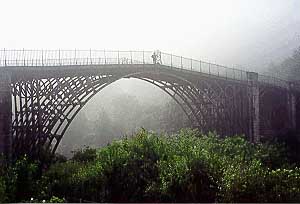| |
| |
|
| |
| |
| |
||
| |
||
| |
||
|
|
|
the Ironbridge
Because the trade of ironworking had not yet developed, the bridge was constructed by woodworkers, who crafted the individual members in wood, made sand molds of the pieces, and poured molten metal into them to form cast iron members. These members were then used to construct the bridge, but were connected with traditional woodworking joints such as mortise-and-tenon and dovetails, rather than bolts or rivets. The problem with cast iron is that it is brittle, as opposed to wrought or malleable iron, and steel, which are ductile materials. Brittle materials do not "give" or deform much, but fracture rather suddenly, generally without warning. Ductile materials, on the other hand, will undergo significantly more yielding, or change of shape, before breaking, and are therfore more desireable for structures such as a bridge. Put another way, the difference between cast and ductile iron is analogous to the difference between a piece of chalk and a paperclip. Try to bend the chalk, and it will break suddenly; do the same to the paperclip, and it will readily deform but remain intact and retain much of its strength. It is because of this inability of cast iron to yield that the Ironbridge today has a number of members which have fractured, and the bridge has been closed to vehicular traffic, although it will still carry pedestrians. The construction of the Ironbridge ushered in a revolution in bridgebuilding. It was not long until wrought, or ductile, iron began to be produced, and bridges spanning hitherto undreamed of lengths began to be constructed. Thomas Telford, the great British civil engineer, built iron bridges—such as the 1814 cast-iron bridge over the River Spey in Scotland—that remain as models of their time. Isambard Brunel, another British civil engineer, and Gustav Eiffel, creator of the Eiffel Tower in Paris, used ductile iron and steel to rapidly push the boundaries of possibility in bridgebuilding, and by the end of the 19th century had revolutionized the whole bridge design and construction process.  Click for a larger (43k) graphic Click for a larger (43k) graphicphotos © Campbell Huth |
